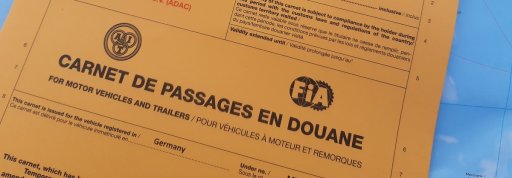
Inventor I
- 13,232
- First Name
- Bjoern
- Last Name
- Eldracher
- Member #
-
20111
- Ham/GMRS Callsign
- DO3BE

Since questions about the Carnet de Passages have already been asked here in the forums several times, I have summarized what I consider to be the most important points. I think that this is maybe of help to a few overlanders here.
If you are planning a long-distance trip, perhaps to Australia or Africa, you have probably already come across the Carnet de Passages (CdP for short). It all sounds terribly complicated, but it's not at all. In the following, I will show you what a CdP is, where you need a CdP, how to get the document and how to use it.
What is a CdP?
The CdP is your vehicle's passport. That sums it up quite well. The CdP contains a precise description of your vehicle, for example the chassis and engine number. In some popular travel countries, you need this additional document to temporary import your vehicle. Sometimes it is mandatory, sometimes it is easier than with a Temporary Import Permit (TIP for short) which is also often used at borders. The CdP is a customs document and an internationally recognized guarantee for the payment of customs and import duties, which allows you to import your vehicle into another country duty-free for a limited period of time. This is because, in principle, you are importing goods when you cross the border - in the form of your vehicle. And import duties are usually due for this.
You pay a deposit for the issuance of a CdP, which is used to settle the customs debt if the vehicle remains in the country, e.g., if it is sold within the country. The amount of the deposit to be paid depends on the issuer, value of the vehicle and the region in which the CdP is to be valid. Check with the issuing automobile club.
So, when do you need a CdP?
A CdP is mandatory in Australia and New Zealand, in some African countries, in some countries of the Middle East and some other travel destinations. In some countries it is recommended. Check with your local automobile club for most actual information before you go.
Pay attention: If you use it in countries where it is not mandatory, then pay particular attention to the correct handling at the borders to avoid problems later. This is because border officials are not always familiar with it. I will explain later how to use the document correctly.
By the way, in practice, as is so often the case, things can look very different and although almost everyone will probably tell you that a CdP is mandatory for certain African countries, there are of course always other overlanders who prove that there are other ways.
How to get a CdP?
CdPs are administered by the Alliance Internationale de Tourisme (AIT) and the Federation Internationale de l'Automobile (FIA). The issuing itself is usually delegated to the local AIT/FIA automobile clubs. In Germany, this is the ADAC for example. The cost of the issuing is often around 250 euros, sometimes more. There may be additional costs if delivery/forwarding by courier is desired or necessary.
Yes, sometimes people try to get a CdP from other automobile clubs abroad as it is maybe cheaper there or the deposit is lower. However, at least according to pure regulation and in general, the local club must grant an exemption before. Here, too, there are reports from practice that this sometimes works. However, I can only advise not to mess around with anything, do not mess with officials and this includes the customs. After all, you are responsible for the correct import and export and the correct declaration and the consequences that may arise.
For the application you need in general:
- the signed application
- a copy of the applicant's passport or identity card
- a copy of the registration certificate of the rig
- if applicable, the declaration of assumption of debt signed by the vehicle owner, if you are not the owner
- a bank guarantee instead of the deposit payment, if applicable
To apply, fill out the application form and send it by post or e-mail together with all documents (scans) in good time before the start of your trip to the issuer. The deposit must be transferred in advance to the account specified by the issuer, as well as the issuing costs. The certificate is usually valid for one year.
What if the CdP expires during the journey?
If you are continuing your journey after the CdP has expired, obtain a follow-up CdP in good time. Then you will need the same documents as for the initial application. You send this back to the issuer a few weeks before it expires. Often, the issuer can send the new carnet by courier to many countries around the world when you pay the costs.
With the old CdP still valid, you then leave the current country, have it stamped out and enter the next country with the new CdP. In some countries it is also possible to have the new CdP stamped in the country. It is best to find out about this locally. Send the expired CdP back to the issuer in the safest possible way. Sometimes the issuer needs more information like additional copies and infos, etc. Check in advance.
Another option, when the Carnet de Passage expires is to extend it in the country, which is usually possible for up to three months but does not entitle you to travel on to another country. You must apply for this extension at the issuer and the local automobile club in the country of travel I good time before the expiration.
Handling of the CdP – how to use?
When you receive the CdP with the post or by courier, make a copy of all important documents and keep them separate and safe as always. This can help in the event of loss. Also check the CdP carefully for completeness and correctness of the information upon receipt and do not foget to sign it. You are liable for the consequences of the loss or misuse of this document and it remains the property of the issuer. Therefore, keep it very carefully.
The CdP has usually 25 pages for border formalities. Each page is divided into three parts. The bottom part (importation voucher) is stamped and detached when entering a country and remains at customs. When leaving the country, the middle section (exportation voucher) is stamped and detached. It also remains with customs. The third section (counterfoil) is stamped on entry and exit. It remains in the CdP and is your proof of correct import and export from the country in question. Pay attention: at the borders, check and make sure that everything is done correctly! The repayment of your deposit and possible customs claims depend on clean and proper documentation!!!
When you return to your home country or re-enter the home custom union, the CdP is stamped for the last time and the certificate of location (also within the CdP) gets completed. You then present this to the issuer and - once it has been checked and if everything is in order - you will receive your deposit back. So, if irreparable damage occurs due to an accident, loss or theft of the rig happens and the vehicle remains in the country, you must have this documented by the local police and coordinate the further procedure with the customs authorities and the issuer. This is very important.
Many travel plans are very individual, so it is not possible to go into every detail. But I hope that this overview can help some of you. If you have any questions, just shoot me a message, I'll be happy to help.
Safe travels,
Bjoern
Last edited:


